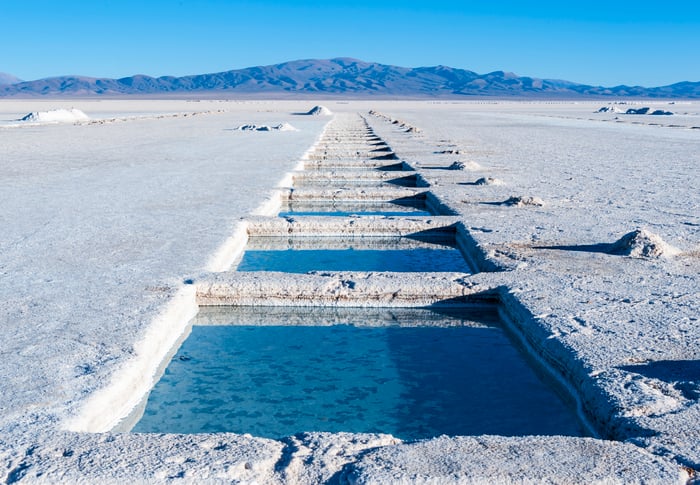Lithium mining stocks have been having a great year. Shares of the three largest lithium producers listed on a major U.S. stock exchange -- Albemarle (ALB 0.93%), Sociedad Química y Minera de Chile (SQM -3.39%), or SQM, and Livent (LTHM) -- returned 57%, 155%, and 63%, respectively, over the one-year period through May 31. The S&P 500 index returned negative 0.3% over this period.
The rising demand for lithium is primarily being driven by growing consumer adoption of electric vehicles (EVs). The silvery-white metal is used to make the lithium-ion batteries that power EVs.
This article covers the two current types of lithium mining operations and briefly mentions several other types that are being explored. It's intended to lay the groundwork for a series, whose goal is to help investors make smarter investment decisions in this complex and rapidly growing industry.
While the "who" and "where" of lithium mining aren't the core focuses of this article, it will touch briefly upon some of the main companies and geographies that fall into each section. These topics will be covered in more depth in future articles.

A salt flat or salar. Image source: Getty Images.
Brine mining
In the most common method of lithium brine mining, brine (salty water) that contains lithium chloride and other salts is pumped from reservoirs that lie beneath dried lake beds into above-ground evaporation ponds. Arid weather conditions and high elevations help the water in these ponds evaporate faster than it would in other climates and geographies.
The lithium chloride that is left is then processed into lithium carbonate, which is then sometimes further processed into lithium hydroxide, as well as other premium lithium products. Both lithium carbonate and lithium hydroxide can be used to produce lithium-ion batteries, but lithium hydroxide has emerged as the preferred compound for making EV batteries.
Livent, based in the United States, has a proprietary brine extraction technique, which differs somewhat from the process just described.
The major players in extracting lithium from brine include U.S.-based Albemarle, Chile's SQM, and Livent. Albemarle and SQM both have operations at Salar de Atacama in Chile. (Salar is the Spanish word for salt flat.) They pay royalties to the Chilean government, which owns this resource. It's Albemarle's primary brine operation and SQM's sole source of lithium. Livent's sole source of lithium is the Salar del Hombre Muerto in Argentina, which it owns.
China's Ganfeng Lithium is on track to join the significant players in mining lithium from brine. It is part owner of two brine resources in Argentina, with one project nearing the commercial stage.
Extracting lithium from underground brine has historically been a more cost-effective method than mining it from hard rock.
Hard-rock mining
Hard-rock mining is the other way lithium is now currently obtained for commercial use. This type of mining is what most folks probably think of when they hear the term "mining." It involves open-pit mining of ore containing the lithium-bearing mineral spodumene.
The spodumene is processed into a concentrate and then further processed into premium lithium products, notably lithium hydroxide. Unlike the lithium chloride that's obtained from brine mining, spodumene concentrate can be directly processed into lithium hydroxide.
Most hard-rock lithium mining is in Australia and China. China's Tianqi Lithium, Albemarle and Ganfeng are the major players in this sphere. Together with Albemarle, SQM, and Livent, China's duo of Ganfeng and Tianqi make up the top five lithium producers. (Tianqi owns a 24% stake in SQM, so it's indirectly a notable player in mining lithium from brine.)
Other types of mining operations are being explored and developed
Soaring lithium prices have been leading many companies to explore other potential sources of lithium and methods of mining that might now be feasible economically, as well as technically.
Numerous companies are in the exploration and development stages of obtaining lithium from clay, geothermal brine (a byproduct of geothermal energy production), and oil field brine.





